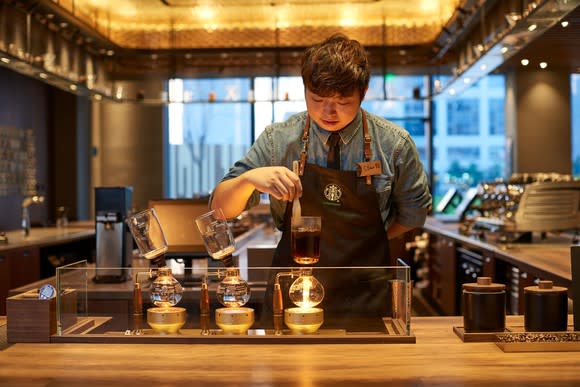2 Top Stocks to Buy in the Coffee Sector
While the coffee market in the United States has become fairly saturated, that doesn't mean the strongest players don't have room to grow. Starbucks (NASDAQ: SBUX) may not be able to add many more stores in its home market, but it can eke out sales increases at existing locations, expand internationally, and evolve its concept beyond its traditional cafes.
In a different way, that's also true for Keurig Dr Pepper (NYSE: KDP). The company dominates the U.S. single-serve coffee-pod segment, but it has shown that it can grow by adding partners and brewer options. Both of those companies have forced everyone else pouring customers a cup o' Joe -- from rivals like Dunkin' (NASDAQ: DNKN) to fast-food chains and convenience stores -- to up their coffee game.
They also continue to create opportunities for investors to profit from the still-evolving coffee market. These top stocks have strong long-term upsides.

Starbucks is opening roughly one store every day in China. Image source: Starbucks.
1. Keurig Dr. Pepper
When Keurig was taken private by JAB Holdings, it stopped publicly reporting its numbers, which left onlookers with a lot of questions about whether its business had peaked. Since the company came back into the markets by purchasing Dr. Pepper Snapple Group to form Keurig Dr Pepper (NYSE: KDP), it has only reported once, but the numbers were encouraging.
Sales of single-serve coffee were up 7%, and operating income from sales of the company's various brewers rose by 26%. That's encouraging, as it demonstrated consumers are interested in the three new machines (two that make lattes and a new-look K-Mini) the company released in Q3.
Keurig has additional upside because JAB, with its a huge portfolio of coffee brands, remains its majority shareholder. That makes it much easier for it to tack on partners from within the JAB family of brands -- like Peet's, which it recently added.
Further compounding its advantage, thus far, no serious rival has emerged to K-Cups domestically. Starbucks appears to have largely abandoned its Verismo brewer, and Nespresso machines remain a small niche player in the U.S. market. That puts Keurig in a strong position when it comes to drawing new coffee brands onto its platform.
2. Starbucks
This is a "don't bet against the market leader" pick. Starbucks has a lot of rivals, but it also has some pretty large advantages. In the U.S., while it may have saturated the market in most places, it can still increase sales by tweaking its product mix, and using its technology and rewards program to boost sales to its most frequent customers.
The coffee giant has been working to better use both its rewards program contacts and the email addresses it collects when people use its free WiFi. Among its tactics, it has been offering customers who usually visit in the morning special deals if they come back in the afternoon. That should help the company increase sales during traditionally slower dayparts, and also drive interest in new food or drink offerings.
The chain also sees an opportunity with its premium brand. It plans to add "Reserve" bars to about 20% of its stores. The pricier, limited-availability drinks and food from that secondary brand would increase its average check size.
Outside the U.S., the company has a huge opportunity to grow in China. It has been opening new restaurants there at a rate of one a day, and will continue at that pace for the next few years.
Beyond that, Starbucks also should be able to grow its ready-to-drink business around the world through its new deal with Nestle (NASDAQOTH: NSRGY). Under the agreement, Nestle will take over selling Starbucks products into grocery stores, supermarkets and other retailers outside of the U.S., which should increase the brand's already significant reach.
Why no Dunkin'?
It was tempting to add Dunkin' to this list of recommended investments, but the chain has struggled with its identity in recent years. It has condensed its menu, dropped "Donuts" from its name, and recently upgraded its espresso game.
Whether or not these changes pay off will determine whether coffee has a "Big Three" instead of a "Big Two." Dunkin' has a strong brand, but it needs to establish a stronger customer base. Right now, it straddles being a lower-end option compared to Starbucks, and being a wannabe gourmet coffee provider that doesn't quite deliver.
For now, Starbucks and Keurig Dr Pepper are the clear plays in the coffee space. Both dominate their respective markets, and even with lots of rivals going after their customers in various ways, neither has shown any real signs of weakness.
More From The Motley Fool
Daniel B. Kline has no position in any of the stocks mentioned. The Motley Fool owns shares of and recommends Starbucks. The Motley Fool recommends Dunkin' Brands Group and Nestle. The Motley Fool has a disclosure policy.

 Yahoo Finance
Yahoo Finance 